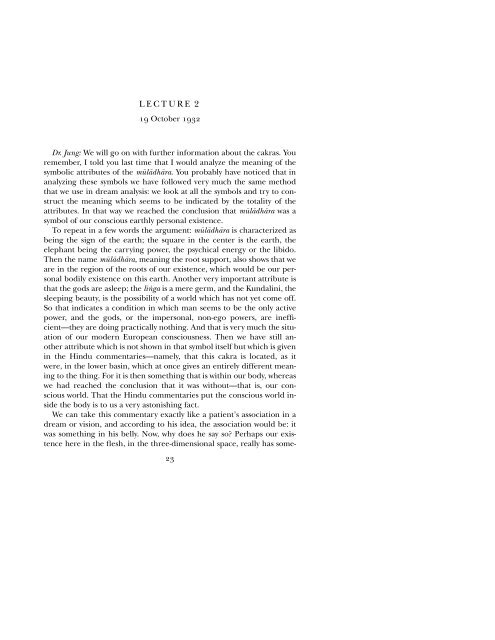CG JUNG - Countryside Anarchist
CG JUNG - Countryside Anarchist
CG JUNG - Countryside Anarchist
Create successful ePaper yourself
Turn your PDF publications into a flip-book with our unique Google optimized e-Paper software.
LECTURE 2<br />
19 October 1932<br />
Dr. Jung: We will go on with further information about the cakras. You<br />
remember, I told you last time that I would analyze the meaning of the<br />
symbolic attributes of the mÖlvdhvra. You probably have noticed that in<br />
analyzing these symbols we have followed very much the same method<br />
that we use in dream analysis: we look at all the symbols and try to construct<br />
the meaning which seems to be indicated by the totality of the<br />
attributes. In that way we reached the conclusion that mÖlvdhvra was a<br />
symbol of our conscious earthly personal existence.<br />
To repeat in a few words the argument: mÖlvdhvra is characterized as<br />
being the sign of the earth; the square in the center is the earth, the<br />
elephant being the carrying power, the psychical energy or the libido.<br />
Then the name mÖlvdhvra, meaning the root support, also shows that we<br />
are in the region of the roots of our existence, which would be our personal<br />
bodily existence on this earth. Another very important attribute is<br />
that the gods are asleep; the li´ga is a mere germ, and the Kundalini, the<br />
sleeping beauty, is the possibility of a world which has not yet come off.<br />
So that indicates a condition in which man seems to be the only active<br />
power, and the gods, or the impersonal, non-ego powers, are inefficient—they<br />
are doing practically nothing. And that is very much the situation<br />
of our modern European consciousness. Then we have still another<br />
attribute which is not shown in that symbol itself but which is given<br />
in the Hindu commentaries—namely, that this cakra is located, as it<br />
were, in the lower basin, which at once gives an entirely different meaning<br />
to the thing. For it is then something that is within our body, whereas<br />
we had reached the conclusion that it was without—that is, our conscious<br />
world. That the Hindu commentaries put the conscious world inside<br />
the body is to us a very astonishing fact.<br />
We can take this commentary exactly like a patient’s association in a<br />
dream or vision, and according to his idea, the association would be: it<br />
was something in his belly. Now, why does he say so? Perhaps our existence<br />
here in the flesh, in the three-dimensional space, really has some-<br />
23


